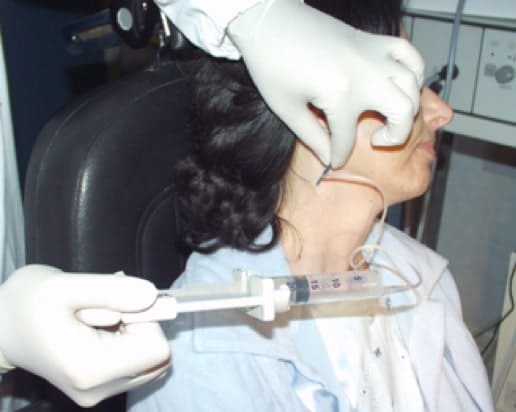Salivary Gland Biopsy
What is salivary gland biopsy and when is it necessary?
 A salivary gland biopsy is a medical procedure that involves taking a small sample of salivary gland tissue for analysis under a microscope. Here is information about salivary gland biopsy and the situations in which it is performed:
A salivary gland biopsy is a medical procedure that involves taking a small sample of salivary gland tissue for analysis under a microscope. Here is information about salivary gland biopsy and the situations in which it is performed:
Salivary gland biopsy is a minimally invasive surgical method used for the diagnosis of the etiopathogenesis of sicca syndrome or systemic autoimmune diseases such as amyloidosis, sarcoidosis or Sjögren's syndrome.
Salivary gland biopsy allows the complete diagnosis of the majority of conditions located in the mouth, cervical and of the face.
Accessory salivary gland biopsy is the most common method for collecting a sample of salivary gland tissue because it carries less risk of complications for the patient.
In certain cases, however, it is necessary to biopsy the main salivary glands or the sublingual gland.
Salivary gland biopsy is indicated to confirm the diagnosis of three diseases: Sjögren's syndrome, sarcoidosis and sarcoidosis. amyloidosis.
Salivary gland biopsy is also used to evaluate salivary gland inflammation in other autoimmune diseases , such as rheumatoid arthritis.
How is the salivary gland biopsy procedure carried out and what are its objectives?
The biopsy of the salivary glands is carried out under local anesthesia.
Accessory salivary gland biopsy is the most common method for collecting a sample of salivary gland tissue because it carries less risk of complications for the patient.
In certain cases, however, it is necessary to biopsy the main salivary glands or the sublingual gland.
Salivary gland biopsy helps confirm the diagnosis of three diseases: Sjögren's syndrome, sarcoidosis and amyloidosis.
Salivary gland biopsy is also used to evaluate salivary gland inflammation in other autoimmune diseases , such as rheumatoid arthritis.
Accessory salivary gland biopsy involves taking a fragment of tissue from the salivary glands under the mucosa of the lip lower.
Salivary gland biopsy requires local anesthesia and can be performed on an outpatient basis.
Salivary gland biopsy results may take several days or weeks.
Salivary gland biopsy results can confirm the diagnosis of autoimmune and inflammatory diseases of the salivary glands.
What are the common indications for a salivary gland biopsy in the diagnosis of salivary disorders?
Common indications for a salivary gland biopsy in the diagnosis of salivary disorders are:
Confirm the diagnosis of three diseases: Sjögren's syndrome, sarcoidosis and amyloidosis.
Assess salivary gland inflammation in other autoimmune diseases, such as rheumatoid arthritis.
Diagnose the etiopathogenesis of sicca syndrome or systemic autoimmune diseases such as amyloidosis, sarcoidosis or Sjögren's syndrome again.
Assess for the presence of granulomas, clumped lymphocytic inflammation, or non-tissue material.
Assess for tumors or masses in the salivary glands.
What are the potential results of a salivary gland biopsy and how are they interpreted?
Positive result: If the tissue sample taken during the salivary gland biopsy shows signs of inflammation, this may indicate the presence of an autoimmune or inflammatory disease of the salivary glands. In this case, the patient may require appropriate treatment to reduce the inflammation.
Negative result: if the tissue sample taken during the salivary gland biopsy does not show signs of inflammation, this may indicate the absence of autoimmune or inflammatory disease of the salivary glands. In this case, the patient may not require additional treatment.
False negative: in rare cases, salivary gland biopsy may give a negative result even though the patient has signs of autoimmune or inflammatory disease of the salivary glands. In this case, the patient may require additional tests to confirm the diagnosis.
What are the risks and possible complications associated with this procedure?
Possible complications associated with this procedure are:
Pain or discomfort in the sampling area.
Bleeding.
Infection.
Swelling.
Hematoma.
Temporary or permanent nerve damage.
Facial paralysis.
Cutaneous necrosis.
Allergic reaction to anesthesia.
What is the typical follow-up after a salivary gland biopsy and what are the possible treatments based on the results?
Follow-up after a salivary gland biopsy may vary depending on the nature of the disease and the results of the analysis. Here is some general information about follow-up after a salivary gland biopsy:
Salivary gland biopsy results may take several days or weeks.
If the salivary gland biopsy results are positive, i.e. there is signs of autoimmune or inflammatory salivary gland disease, the patient may require appropriate treatment to reduce inflammation.
If the results of the salivary gland biopsy are negative, i.e. there is no There are no signs of autoimmune or inflammatory salivary gland disease, the patient may not require additional treatment.
Patients should discuss salivary gland biopsy results and treatment options available for their condition with their doctor .
Patients may require regular follow-up exams to monitor disease progression and the effectiveness of treatment.